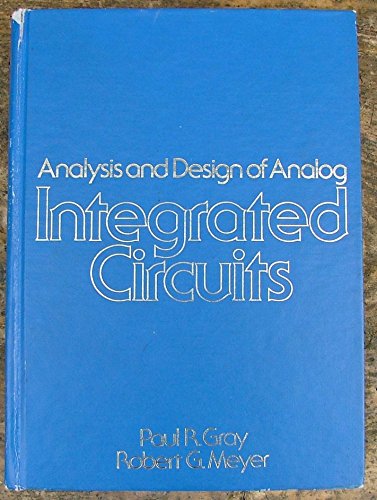This is the only comprehensive book in the market for engineers that covers the design of CMOS and bipolar analog integrated circuits. The fifth edition retains its completeness and updates the coverage of bipolar and CMOS circuits.
A thorough analysis of a new low-voltage bipolar operational amplifier has been added to Chapters 6, 7, 9, and 11.
Chapter 12 has been updated to include a fully differential folded cascode operational amplifier example. With its streamlined and up-to-date coverage, more engineers will turn to this resource to explore key concepts in the field.
THE CLASSIC APPROACH TO CUTTING-EDGE ANALYSIS AND DESIGN In this Fourth Edition of ANALYSIS AND DESIGN OF ANALOG INTEGRATED CIRCUITS, Paul Gray and Robert Meyer have teamed up with two new coauthors-Paul Hurst and Stephen Lewis-to provide a current, comprehensive and in-depth treatment of analog integrated circuit analysis and design. The authors combine bipolar, CMOS, and BICMOS analog integrated-circuit design into a unified presentation that stresses their commonalties and highlights their differences. Readers will gain valuable insights into the relative strengths and weaknesses of these important technologies.
The Fourth Edition features new and expanded coverage of several key technologies and techniques, including increased emphasis on CMOS circuits in Chapters 3-7; a new chapter covering fully differential amplifiers and common-mode feedback circuit analysis using return ration in addition to the two-part feedback analysis; and new coverage of two-stage MOS op-amp compensation, single-stage op amps, and nested Miller compensation.
FEATURES
- Coverage of cutting-edge topics. The new edition features more advanced CMOS device electronics, including short-channel effects, weak inversion and impact ionization.
- State-of-the-art IC processes. The text shows how modern integrated circuits are fabricated, including recent issues like heterojunction bipolar transistors, copper interconnect, and low permittivity dielectric materials.
- Unified treatment of bipolar and CMOS circuits. This format takes readers through each step in designing real-world amplifiers in silicon.
- Open-ended design problems. A number of open-ended design problems, included in the problem sets, exposes the reader to real-world situations where a range of circuit solutions may be found to satisfy a given performance specification.
- Extensive use of SPICE. SPICE is an integral part of many examples in the problem sets.
